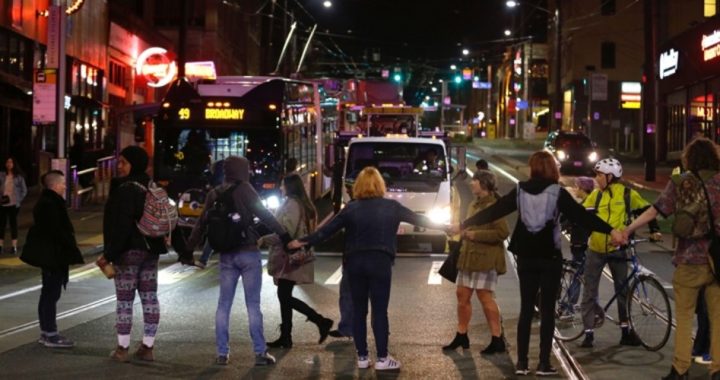
On November 9, the day after Republican presidential nominee Donald Trump’s electoral victory, a number of disruptive protests — some of them violent — erupted in several cities across the United States.
The New York Times reported that in Berkeley, California, which has been the location of many radical protests since the Vietnam War era 50 years ago, a group of protesters marched past empty fast-food restaurants during the early morning hours.
“We can’t just sit back and let a racist and sexist become president,” the Times quoted Adam Braver, a 22-year-old political science student at the University of California, Berkeley as saying. “[Trump] makes us look bad to the rest of the world,” Braver said, as the demonstrators reached the neighboring city of Oakland. “This is the beginning of a movement.”
The Times reported that some cars on the road honked in apparent support of the demonstrators.
Marchers told reporters that the protest had begun spontaneously among students who had gathered on the Berkeley campus to watch the results. When it became clear that Trump would win the presidency, some students filled a wide avenue and began marching toward Oakland.
Oakland police officers attempted to block the marchers before they reached police headquarters. One demonstrator displayed a sign to the police standing in their path that read, “Trump is a fascist pig.”
The crowd broke windows on five businesses and vandalized another, said Oakland police spokeswoman Johnna Watson. Although one citation was issued, no one was arrested.
In Portland, Oregon, dozens of protesters blocked traffic and caused a delay for trains running on two light rail lines. As the crowd grew to about 300 people, some sat in the middle of the road to block traffic. The Times reported that the crowd of anti-Trump protesters burned American flags and chanted “That’s not my president.”
In Seattle, Washington, another group of protesters gathered in the city’s Capitol Hill neighborhood, where they blocked roads (shown) and set a trash bin on fire.
Across the country, in Pittsburgh, hundreds of University of Pittsburgh students marched through the streets. The student-run campus newspaper, the Pitt News, posted on Twitter about an event later on November 9 entitled “Emergency Meeting: Let’s Unite to Stop President Trump.”
Trump may have earned the unique distinction of becoming the first president-elect to inspire such outspoken demonstrations within hours of being elected.
A report in the Boston Globe about the protests in Oakland put the number of protesters in downtown streets at more than 100. KNTV-TV reported that protesters burned a Trump effigy, smashed windows of the Oakland Tribune newsroom and set tires and trash on fire.
Southern California did not escape the protest fever. The Los Angeles Times reported that soon after Trump delivered his victory speech in New York, an estimated 2,000 people converged at UCLA as two separate demonstrations merged into one, according to UCLA police Sergeant Miguel Banuelos.
The group marched from the campus through Westwood Village to a federal building on Wilshire Boulevard, Banuelos said.
The Times reported that the demonstration peaked about 1:00 a.m., when a Trump piñata was set on fire in a trash can outside a store on the city’s Westwood Boulevard.
Further to the north, hundreds marched near the UC-Santa Barbara campus, with some chanting, “Not my president. Not my president.”
If this rash of demonstrations is any indication of the mindset of Hillary Clinton’s supporters, it does not indicate that tolerance and respect for our election process is one of their strongest qualities.
Photo of protesters in Seattle: AP Images
Related articles:
Trump Wins in Historic Anti-establishment Uprising; Will He Deliver?



